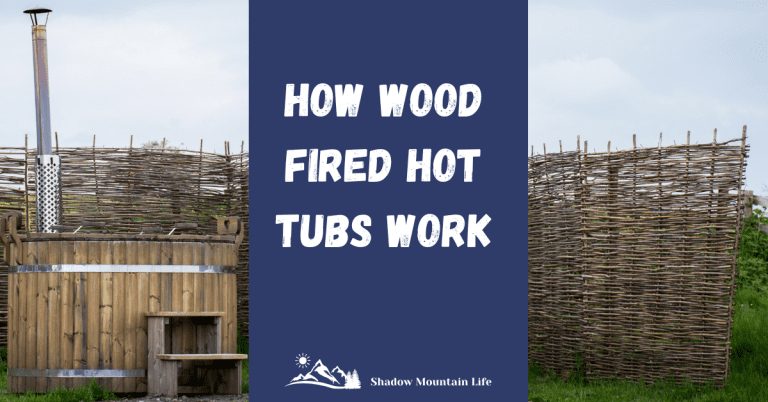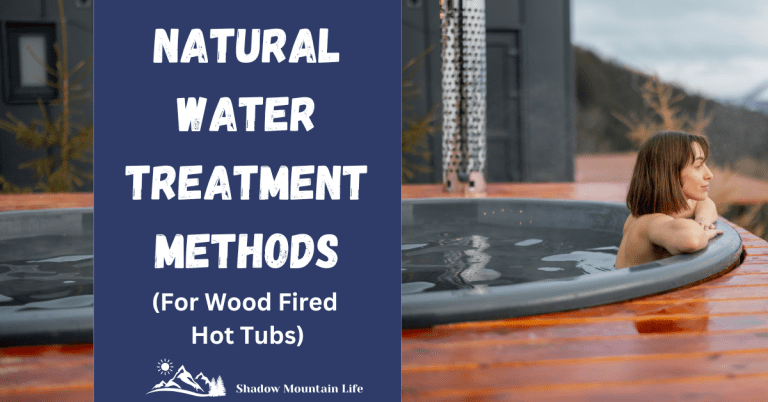The Best Firewood for Heating Wood Fired Hot Tubs
Did you know that choosing the right firewood can reduce your hot tub heating time by up to 50%? Whether you’re a newcomer to wood fired hot tubs or looking to optimize your current setup, this guide will help you select the best firewood for efficient, long-lasting heat.
New to wood fired hot tubs? Check out our Complete Guide to Wood Fired Hot Tubs: From Installation to Maintenance.
Medical Disclaimer: We are not doctors. The health information in the article is for informational and educational purposes only. Please consult your doctor or other healthcare professional when making medical decisions.
Affiliate Disclaimer: We may make a commission if you purchase something through our links. Thank you!

Understanding the Best Firewood Types for Hot Tub Heating
The key to efficient hot tub heating really comes down to understanding two main types of wood – hardwoods and softwoods. Think of them as the marathon runners and sprinters of the wood-burning world.
Hardwoods like oak, maple, and hickory are your marathon runners. These dense woods will give you the longest, most consistent heat output. The catch? They can be a bit slower to get going.
Softwoods, on the other hand, are your sprinters. Pine, cedar, and spruce catch fire quickly and produce intense initial heat. It’s a good idea to keep a small stack of pine specifically for starting fires.
Moisture content factor is an important consideration when choosing wood. Wet wood is about as useful as a chocolate teapot! Your wood needs to be properly seasoned – ideally below 20% moisture content. A moisture meter handy can be super handy to have available for this reason.

Top Hardwoods for Maximum Heat Output
The sweet spot is using a combination of both wood types. Start with softwoods to get things going, then switch to hardwoods for that long-lasting heat.
1. Oak: Benefits, burn time, and BTU rating
Oak is a great go-to wood for heating your hot tub. Depending on where you are in the country, oak tends to be plentiful and available. It is a dense wood and burns a long time. The BTU output is strong – we’re talking about 27 million BTUs per cord for white oak. Red oak works well too.
New to BTUs? This article and chart help explain!
2. Hickory: Superior heat production and longevity
Hickory was a surprising choice for me as I’ve learned it burns even hotter than oak. The only downside? It’s hard to find in some areas. If you spot some hickory at a reasonable price, grab it fast!
3. Maple: Heat characteristics and availability
Then there’s maple – specifically sugar maple. Don’t let its sweet name fool you; this wood means business. It burns nearly as hot as oak but tends to leave less ash, which means less cleanup (always a win in my book!).
4. Ash: Quick starting properties while maintaining heat
Ash is seriously underrated. It’s got this amazing quality where it can burn hot even when it’s not completely seasoned. It also produces this beautiful, steady flame that’s just perfect for maintaining consistent heat.

Fast-Burning Softwoods for Initial Heating
1. Pine: Pros and cons for hot tub heating
Pine is a trustworthy starter wood. It lights up fast while producing an intense initial heat burst that’s perfect for getting things going. But don’t rely on pine alone or you will be feeding the fire all night long-not exactly a relaxing experience!
2. Cedar: Aromatic properties and heat output
Not only does it catch fire beautifully, but cedar also adds an amazing aromatic element to the experience. Just be careful with the amount you use as the aroma can get quite intense.
3. Spruce: Accessibility and starting characteristics
Spruce is a budget-friendly favorite for starting fires. It’s usually cheaper than pine and cedar, and it lights up like a charm. Split it into smaller pieces than you might think necessary as thinner splits create perfect kindling that gets your hardwoods going in no time.
Ideally start with about 20% softwood to get things going. Then as the water is warming up, transition to the hardwoods for longer burns. Just make sure your softwoods are properly seasoned – wet softwood is not very useful!

Optimal Wood Storage and Preparation
Proper wood storage can make or break your hot tub heating experience!
The key is keeping your wood elevated and covered. A simple storage rack using pallets for the base (keeps the wood about 6 inches off the ground) and topped it with a slanted metal roof. can help keep your wood dry. The slope is crucial – you definitely want that rain and snow to slide off.
Split your wood smaller than you think necessary, like pieces about 3-4 inches in diameter. They not only season faster but also fit perfectly in most hot tub heaters. Give hardwoods a full year to season, while softwoods need about 6 months.
Want to know if your wood is ready? Test by knocking two pieces together. Properly seasoned wood makes a sharp, clear “clunk” sound, while wet wood makes a dull thud. Also, check for those telltale cracks at the ends – they’re like nature’s way of saying “I’m ready for your hot tub!”
Cost Analysis and Efficiency Comparisons
Let’s look at the real costs of heating your hot tub with different woods.
Oak provides a good value. Sure, it costs more upfront and depending on where you live it can run around $400 per cord – but here’s the thing: one cord of oak lasts nearly twice as long as the same amount of pine.
Buying wood in the off-season can save you serious cash, but the key is having enough storage space and planning ahead.
Let’s talk BTUs (British Thermal Units) because this is where the real efficiency shows up. Oak puts out about 27 million BTUs per cord, while pine only gives you around 17 million. Bottom line- if you use only pine, you will be going through your wood stash much faster than if you used oak as well.
By mixing your wood between softwood for quick heating and hardwoods for maintenance heating, you will cut your overall heating costs as opposed to using one type of wood exclusively.
Safety and Environmental Considerations
For sustainability purposes, try and source your wood locally-within 50 miles or so of your home. Not only does this reduce transportation emissions, but it also supports local suppliers. Sometimes local arborists will have free or cheap wood from trees that they have removed. Local Parks & Rec Departments may also have wood they are getting rid of. If you are lucky enough to own some acreage, you may be able to stock your wood supply for free!
Here’s something that surprised me about smoke reduction: the moisture content of your wood affects not just heating efficiency but also air quality. When you use properly seasoned wood (below 20% moisture), the difference in smoke output is incredible! By using a two-zone stacking method for wood – this year’s wood and next year’s wood – will ensure you are always burning well-seasoned logs.
Always check your local regulations before burning – some areas have specific restrictions during certain seasons. Keep a fire extinguisher nearby (replaced annually) and install a spark arrestor on the hot tub heater.
A great way to use all the ash from the firebox is ash recycling. Instead of tossing the ashes, use them in your garden – they’re fantastic for adjusting soil pH. Just make sure they’re completely cool first!
The biggest environmental tip? Burn hot and efficient. A properly maintained, hot fire produces fewer emissions than a smoldering one. It’s better for the environment and your hot tub heating experience!







